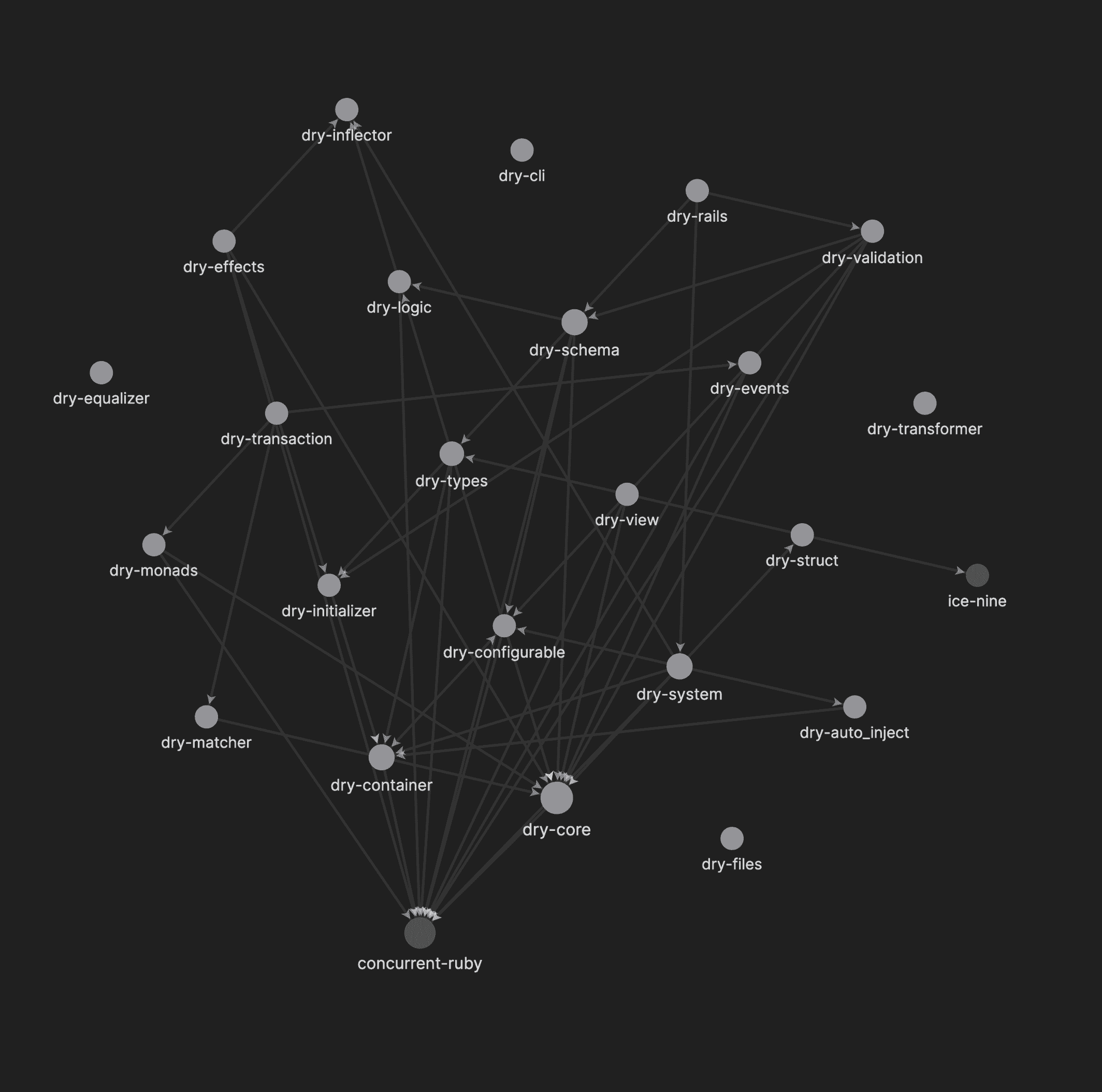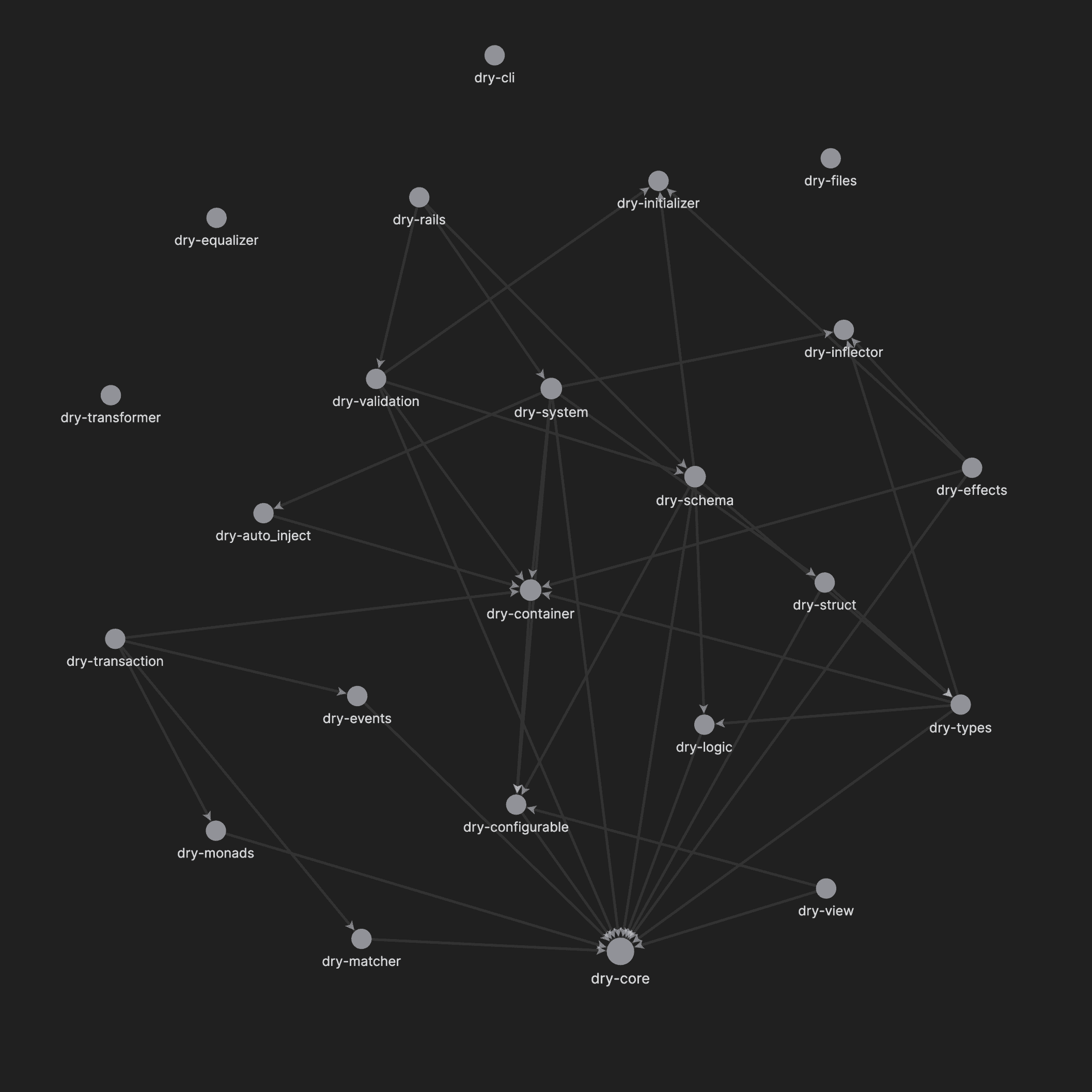When I've been starting to learn DRY-RB gems ecosystem, I've been wondering, what the hell should I start learning first. Which gems are the best to learn at the beginning, and which one I should skip?
I hope in this article I'll be able to put some light on the topic.
Recently, when I've been browsing through the DRY-RB discourse forum, I went through a post from Jed Schneider, suggesting a visualization of dependencies for a DRY-RB family.
I quickly figured out that such diagram may tremendously simplify the decision making when a new developer wants to start learning DRY-RB gems.
I think It's a great idea, so here it is!
Full DRY-RB dependency char
This network diagram shows connections between all the official gems from DRY-RB organization and external libraries.
The darker nodes represent external dependencies.
 DRY-RB full dependency graph with external deps
DRY-RB full dependency graph with external deps
It was surprising to see, that except concurrent-ruby, there are almost no external dependencies. There is ice-nine used for creating deeply frozen objects for structs, but other than that, it's pure Ruby! Amazing!
DRY-RB no external dependencies char
This diagram shows only internal gems connections, for a more simplified view. There are several gems that have no dependencies at all, like dry-transformer which I've already made an episode about or dry-equalizer, or dry-inflector. All of them are very small and focused on doing a single task, which makes them easy to be used in different scenarios.
 DRY-RB internal dependency graph
DRY-RB internal dependency graph
Conclusions
You can quickly identify also key gems for the whole DRY-RB ecosystem, like dry-core, or dry-container which are designed as a base for building more complex gems and libraries. Of course, you still can use them directly in your apps if you see the benefits from it, but it may be harder to find a use case for them.
Sorting DRY-RB libraries based on connections.
The philosophy behind the DRY-RB ecosystem is to provide simple gems that perform single tasks and can be connected together to build more complex abstractions.
Therefore there are gems that are easily applicable for complete web applications and designed to be used within them directly, but also gems that are meant to be used to build other gems and libraries.
Based on the dependency graph, and links between multiple libraries, you can identify some gems that are meant to be used in the applications directly, and others, that can should be rather used as a base for other libraries.
**For example. **
1. Application-level gems
dry-rails depends on dry-validation, dry-system, and dry-schema.
As dry-rails is a pure integration with Rails applications, you can safely assume, that if the core team had put an effort to integrate those three gems with rails apps, those are the entry points to the wide range of application-level use cases.
If I'd have this graph when I started learning DRY-RB, I'd be super happy, as it would remove a lot of overhead from me allowing me to focus on what's easiest to adopt in my web applications.
2. Low-level gems
A lot of gems depend on dry-core, dry-container, which may give you an idea, that those two gems are very useful, but maybe not for direct usage but rather for building your own ruby libraries.
3. Standalone gems
This is a bit misleading because each of DRY-RB gems is "standalone" and can be used independently, only with its own dependencies. However, some gems stand out in front of others even on the graph above, as they have no dependencies and nothing depends on them.
It's worth checking out why those few gems had been created. What kind of tasks had been so important, that they required separate gems to be built?
dry-transformer (see episode #6), dry-equalizer or dry-files are gems that allow to solve common ruby problems without loading anything else.
Summary
If I'd start learning DRY-RB gems now, I'd pick Application-Level gems, like dry-schema and dry-validation. Those are also one of the most popular ones, so there is a great chance there are nice tutorials already published on the web.
Then I'd try to make familiar with some of the super-small gems, like dry-configurable, or dry-inflector, which are easy to understand and quite intutive to use.
Further thoughts
While this graph is useful as a starting point, you cannot figure out everything. For example, one of the most common problems in programming advanced components is solved by dry-configuration. I've talked about it in episode #4, however, you cannot figure it out from this graph.
Also, an amazing micro-library used for string transformations, dry-inflector, have no dependencies, but it's hard to figure out that it's a completely standalone gem, easy to be used everywhere.
To know such things, you will need to go through the DRY-RB documentation or subscribe to our newsletter and follow me on twitter**!
I'll soon publish more episodes and tricks related to DRY-RB family.
Special Thanks!
I'd like to thank Andreas Wagner and Thomas Carr for supporting this project on Github sponsors! I really appreciate that!
If you enjoy this project, consider sponsoring me on Github!
Any support allows me to spend more time on creating this content, promoting great open source projects.
Thanks and see you soon!
Add your suggestion to our discussion panel!
I'll gladly cover them in the future episodes! Thank you!

